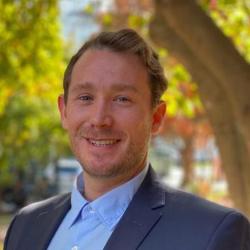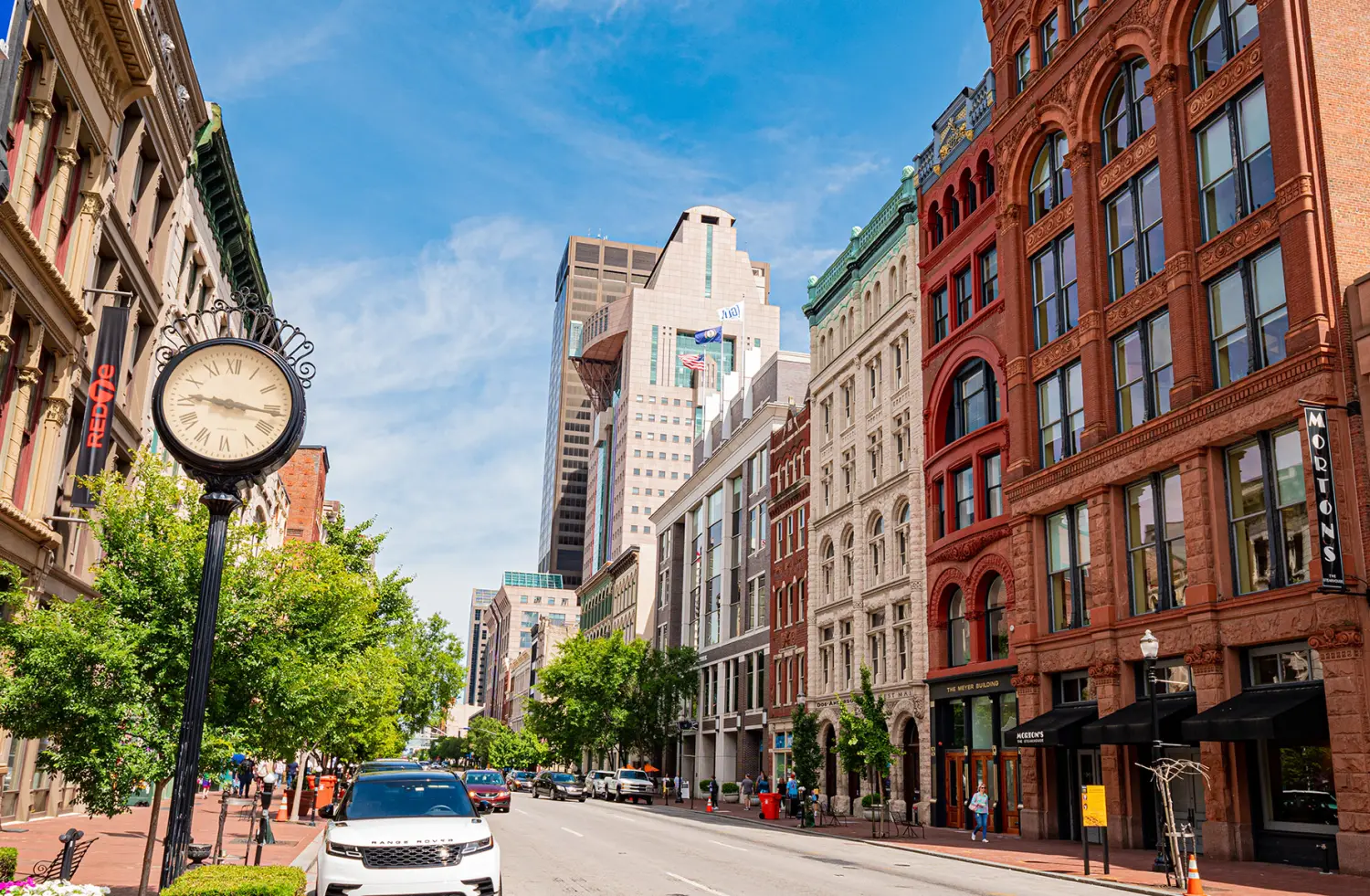For over 50 years, a lack of federal investment in critical infrastructure has remained the status quo. While local stakeholders and environmental advocacy groups have long pushed for sustained investment in climate-resilient infrastructure and the built environment, few federal resources have been available—leaving communities across the U.S. to pick up the tab for crumbling roads and bridges, water and sewer system failures, and the significant environmental, socioeconomic, and public health impacts of degrading public spaces. In the American Society of Civil Engineers’ 2021 report card of U.S. infrastructure, the estimated cost of this disinvestment topped $2.6 trillion.
Addressing this funding gap has been one of the top priorities of the Biden-Harris administration’s Investing in America agenda, most clearly exemplified through the Infrastructure Investment and Jobs Act (IIJA) and Inflation Reduction Act (IRA). Yet, the American Rescue Plan Act’s (ARPA) State and Local Fiscal Recovery Funds (SLFRF) program has also been a uniquely flexible source for local governments to invest in infrastructure. This analysis shows that in making these investments, large local governments are not only advancing their goals of obligating their SLFRF allocations ahead of the December 2024 deadline, but they are doing so in ways that strengthen their built environment, create economic opportunity, and redress past environmental injustices.
About the Local Government ARPA Investment Tracker
This piece accompanies our latest update to the Local Government ARPA Investment Tracker, a joint project of Brookings Metro, the National Association of Counties (NACo), and the National League of Cities (NLC). Since 2021, we have monitored how U.S. cities and counties with populations greater than 250,000 have appropriated, obligated, and spent $65 billion in SLFRF allocations to foster an equitable economic recovery from COVID-19. This update reflects plans from more than 16,000 projects reported by 336 local governments (92 cities and 244 counties) to the U.S. Department of the Treasury through March 31, 2024. All recipients have until the end of 2024 to obligate their allocated funding, and until the end of 2026 to spend the dollars.
As of the end of March 2024, cities and counties with populations greater than 250,000 (“Tier 1”) had appropriated 92% of their $65 billion in SLFRF allocations, and obligated 75% of these funds. For more information about how data is collected and analyzed for this project, please visit the dashboard.
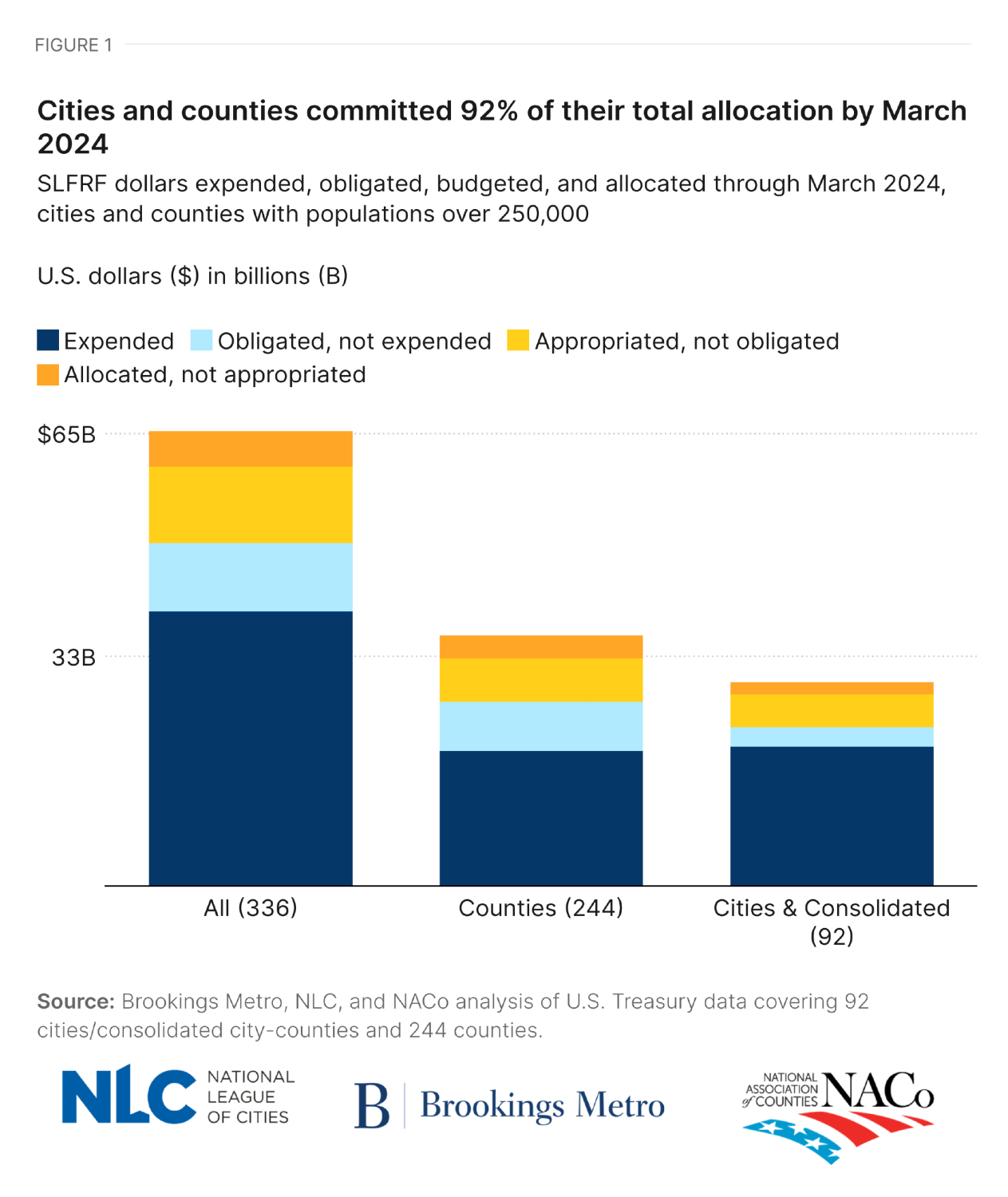
Large cities and counties have committed over one-fifth of their SLFRF appropriations to infrastructure improvements and economic/workforce development projects
Through March 2024, large local governments (cities and counties with populations greater than 250,000) have committed over $12.4 billion (21%) of their SLFRF investments toward various types of infrastructure improvements, climate resiliency initiatives, and economic development programs. As part of these commitments, over $388 million has been earmarked for neighborhood revitalization (such as brownfield redevelopment and blight remediation), while nearly $240 million has been committed to investments in environmentally sustainable and eco-friendly infrastructure (such as green space or treescape installation and solar retrofits). Many large local governments have also invested heavily in “adjacent” programs that support these capital improvements, such as lead pipe replacement in older apartments and single-family homes.
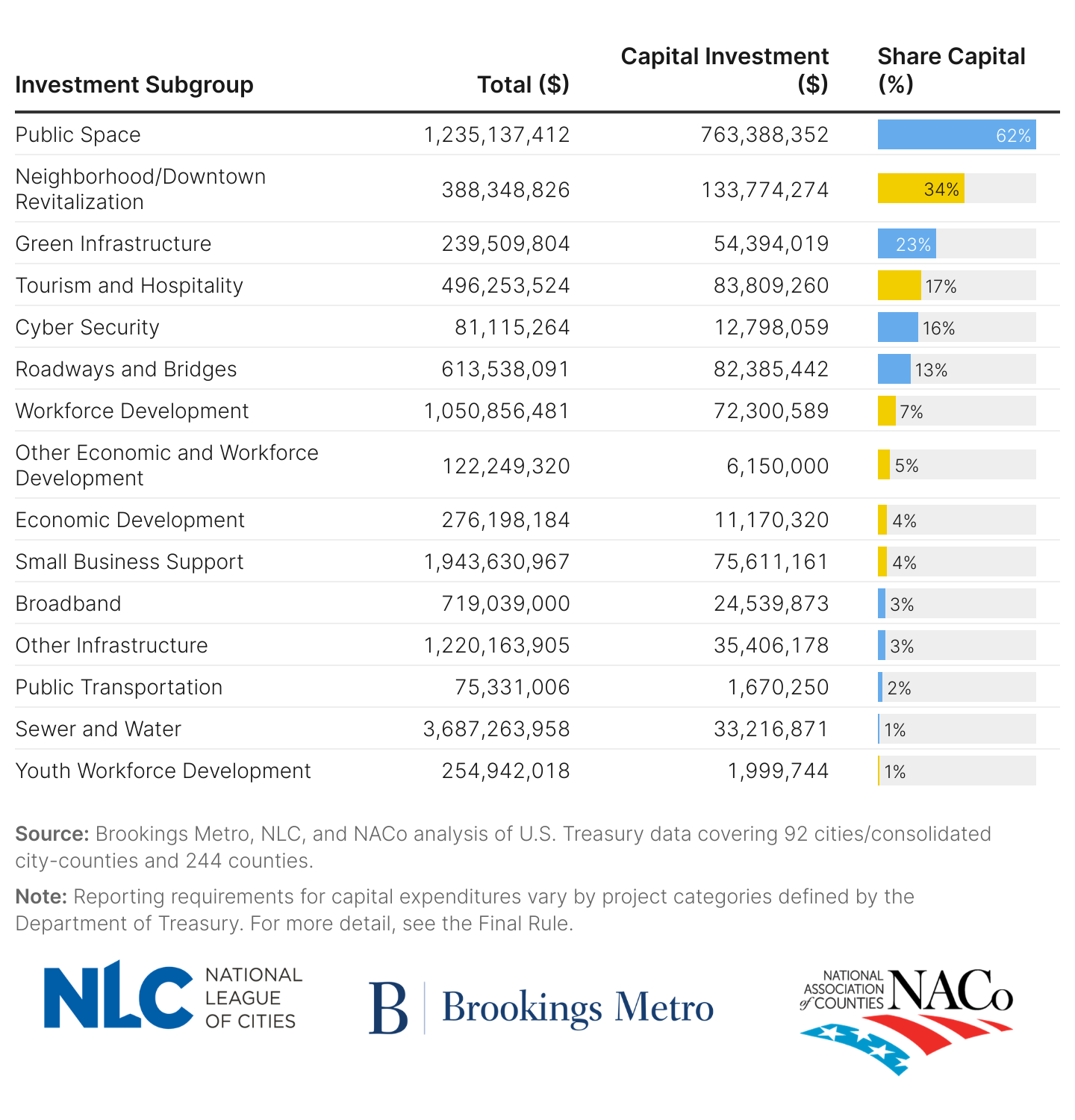
As part of these investments in infrastructure and economic development, many cities and counties are intentionally directing SLFRF investments toward the redevelopment of contaminated former industrial sites known as “brownfields”—a critical step in addressing decades of economic exclusion and environmental vulnerability. While redevelopment sites such as brownfields are typically located in low-income communities and communities of color, structurally racist economic policies such as redlining prevented these same communities from participating in the economic benefits these sites once held, despite bearing nearly all of their associated negative externalities (including land destruction, property devaluation, and increased exposure to heat, crime, and cancerous chemicals).
Decades later, these conditions continue to prevent communities from being recognized as economic assets for developers and site selection consultants, rather than liabilities. Federal investment in high-quality, sustainable, climate-resilient infrastructure and property redevelopment is a necessary step in reversing a pervasive cycle that overlooks the economic potential of these communities. And while SLFRF is just one program in the Biden-Harris administration’s Justice40 initiative (a whole-of-government approach for directing federal funding toward disadvantaged communities), it is unique in the size, scale, and flexibility of investments to advance the initiative’s jobs, justice, and climate objectives.
Some notable examples of these investments by large local governments include:
- Indianapolis’ clean-up and remediation of a 50-acre former industrial site contaminated by hazardous construction materials, lead, and illegal dumping. With the assistance of ARPA funds, site developers will rebuild the area into a neighborhood hub with a light industrial zone and affordable housing units, while hiring workers from within the neighborhood, where average incomes are under $20,000.
- Louisville, Ky.’s remediation of a brownfield where cancerous metals such as arsenic and lead pose a risk to the bordering public apartments and elementary school. Once cleaned, the site will host environmentally and physically safe affordable housing units for the surrounding majority-Black neighborhood, where 42% of residents live below the poverty line. Local voices are at the center of this redevelopment: The Park Hill/Algonquin Community of Opportunity group provides input to private developers and the city to prevent the involuntary displacement of community members.
- Saint Paul, Minn.’s LOCAL Fund: Community Ownership programLOCAL Fund: Community Ownership program, which provides grants and technical assistance to residents of census tracts with high levels of commercial blight to demolish and rehabilitate blighted and abandoned commercial properties. This fund provides residents with a financial and civic stake in local redevelopment. These community-owned projects are also more likely to hire from within the neighborhood, contribute to collective health and safety, and serve diverse populations than those driven by external actors.
- Phoenix’s Residential Tree Equity Accelerator program, which aims to add shade structures and tree canopy coverage in low-income neighborhoods with very low “tree equity” scores. This program—which also creates new workforce development opportunities and paid community forester jobs for workers in these neighborhoods—is an attempt to mitigate the negative environmental and health consequences of extreme heat caused by low access to tree coverage and green space in the hottest city in the United States.
Some cities and counties are matching their infrastructure and economic development investments with grants from other federal programs
One important—and frequently overlooked—impact of the SLFRF program is how it has enabled cities and counties to pilot new programs and scale them through follow-on financing from the IIJA, IRA, and other aligned federal funding streams. For example, the IIJA authorized more than $1.5 billion for the Environmental Protection Agency’s (EPA) Brownfields Program, which is funding the assessment, clean-up, and redevelopment of 350 contaminated properties across the United States. Through the Brownfields Program, Erie County, Penn. was awarded $5 million to support site remediations of two former manufacturing plants that have been contaminated by asbestos, lead, and other groundwater pollutants. Prior to receiving this grant through the IIJA, one of these former manufacturing plants had been selected to receive $750,000 in remediation funding through the county’s ARPA allocation.
Similarly, the U.S. Forest Service has awarded $10 million in IRA funding to the city of Phoenix in support of its ARPA-funded Residential Tree Equity Accelerator program—an award which the mayor lauded as an “acceleration toward a cleaner, cooler, more equitable Phoenix.” Follow-on investments like these are illustrative of how investments made through SLFRF are scalable and stackable with other financial resources, and provide a base from which communities can develop larger, wider-reaching strategies for economic development and community revitalization.
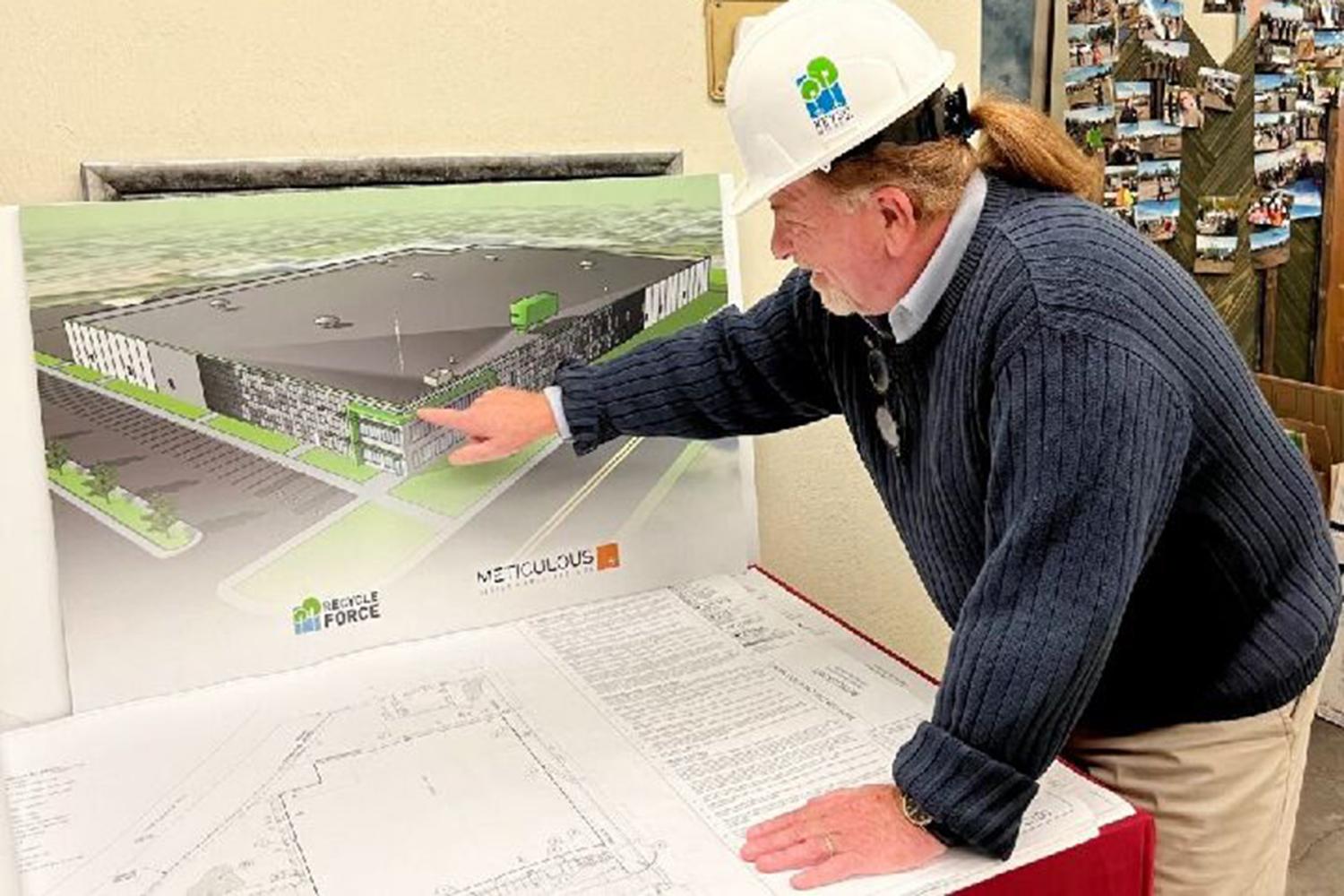
INDIANAPOLIS: The president of RecycleForce looks at plans for a new facility in Sherman Park, where the Department of Transportation’s Thriving Communities Program is funding Indianapolis’ efforts to reconnect Sherman Drive with a multi-modal transportation corridor for residents and workers in the “East Indy Promise Zone.” Prior to receiving this award, the city of Indianapolis-Marion County invested $5 million in ARPA funding into the commercial and residential redevelopment of Sherman Park.
Photo credit: Jill Sheridan/WFYI Indianapolis

ERIE COUNTY, PENN.: The EPA’s mid-Atlantic regional administrator speaks in Erie, Penn. about $5 million in awards made to the region through the agency’s IIJA-funded Brownfields Program. The president of the Erie County Redevelopment Authority has lauded these grants as critical for the county to “finish the work [they] started on two major blighted industrial properties,” which have also received $750,000 in ARPA commitments.
Photo credit: EPA
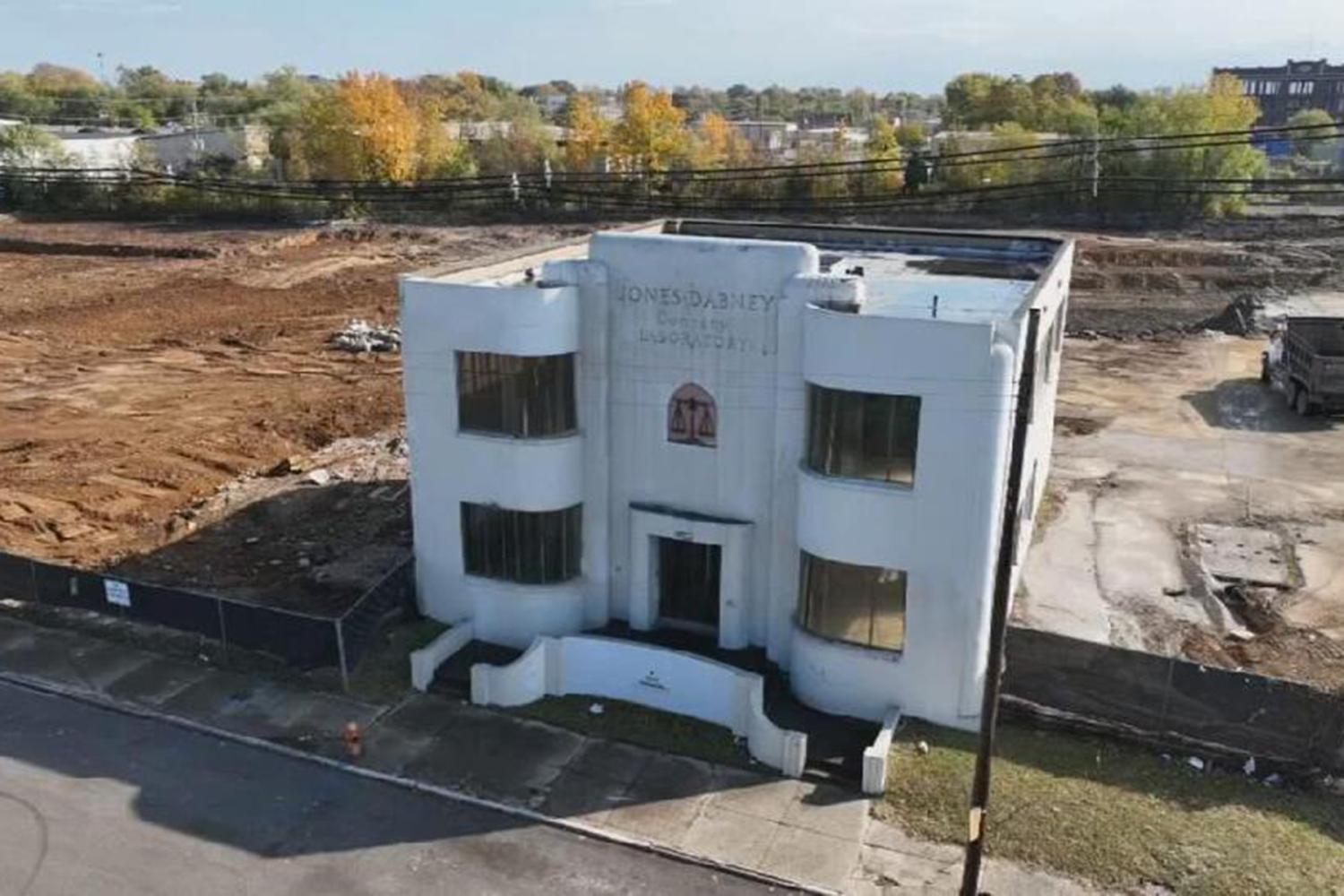
LOUISVILLE, KY.: Environmental clean–up begins at the former Rhodia chemical plant, which the city is using ARPA funding to convert into a mixed-use development. In addition to this ARPA funding, the city has been awarded $500,000 from the EPA’s IIJA-funded Brownfields Job Training Program to create high-wage green jobs for un– and under–employed area residents, who have struggled from a lack of economic opportunity due to the presence of a brownfield.
Photo credit: WDRB Louisville
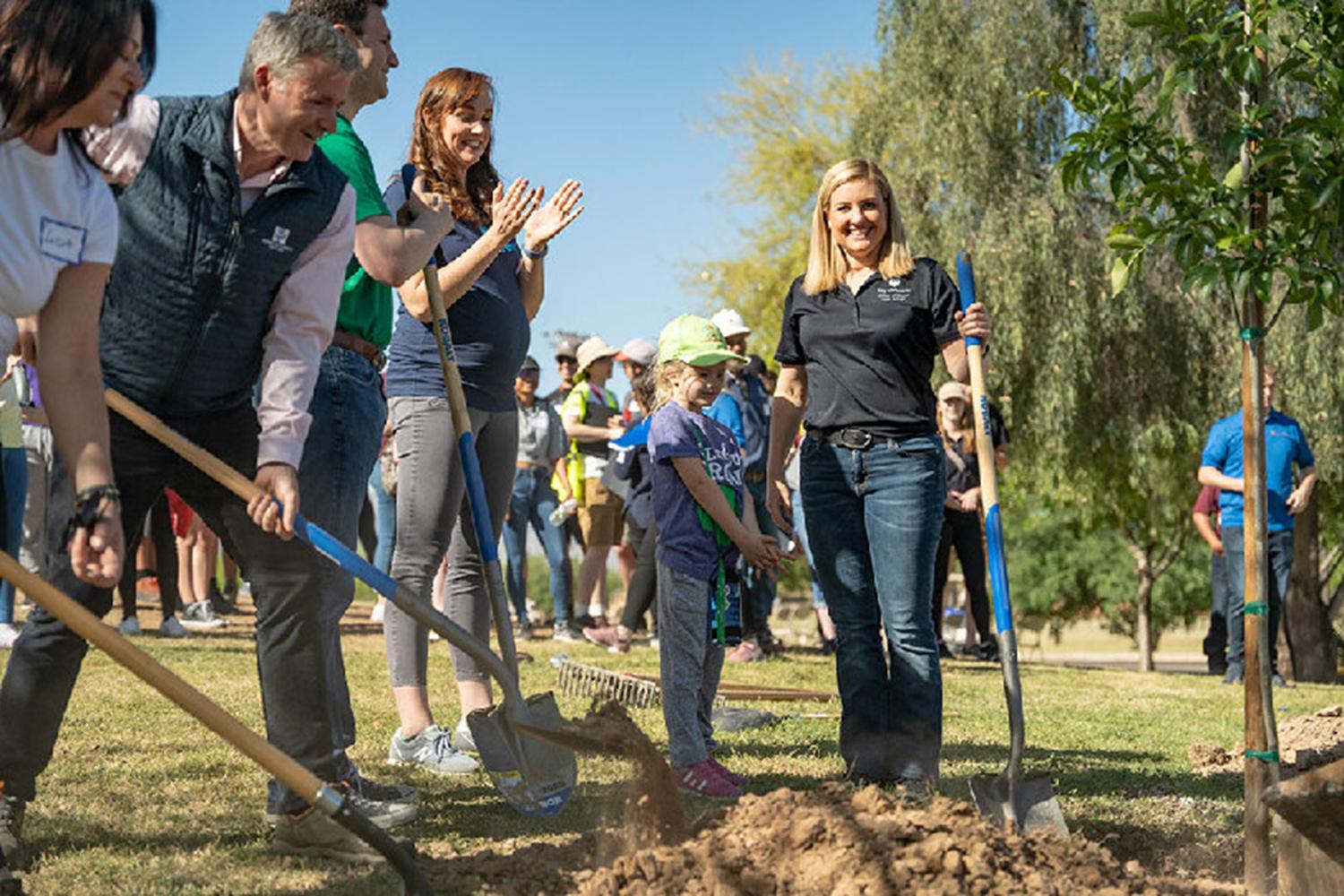
PHOENIX: Mayor Kate Gallego participates in the planting of one of the city’s first “tree corridors”—an effort to cool down neighborhoods with high pedestrian traffic but little tree canopy and green space. The city invested over $17 million in these tree planting efforts in FY 2024 through a combination of ARPA commitments and IRA awards from the U.S. Forest Service.
Photo credit: Michael Jennings / American Forests
Infrastructure investments can foster growth opportunities for historically excluded communities
While more action is needed for the United States to close its $2.6 trillion infrastructure investment deficit, ARPA has provided an unprecedented opportunity for local communities to fill existing gaps without exhausting their own capacity and financial resources, and ensure that more communities can share in the benefits and opportunities created by high-quality, climate-resilient infrastructure.
As the December 2024 SLFRF obligation deadline draws near, it is increasingly important for cities and counties looking to sustain or scale their investments in economic development and revitalization to think about how their work aligns with new funds made available through the IIJA and IRA. As noted by our colleague Adie Tomer at the IIJA’s two-year anniversary, these programs are unique in their comprehensive braiding and blending of “built environment and natural environment programs”—an indication of the importance that communities take care of the opportunities this funding presents now, before Congress returns to its status quo approach to infrastructure investment through smaller, patchwork pieces of legislation.
With 92% of SLFRF dollars appropriated and just months to go until the obligation deadline, it is unlikely that we will see significant changes in how large cities and counties are using ARPA to foster environmental justice and infrastructure revitalization. However, with two more years to spend this funding—and new IIJA and IRA resources continuing to come online—U.S. communities remain positioned to build upon the transformational investments they have made over the past three years and identify where other federal and state assistance can help them continue to build for the future.
Glossary of terms
ALLOCATIONS are the total funds distributed to state and local governments through the Coronavirus State and Local Fiscal Recovery Funds (SLFRF) program.
AMERICAN RESCUE PLAN ACT (ARPA) is the $1.9 trillion economic stimulus and pandemic recovery legislation signed into law by President Joe Biden on March 11, 2021. This legislation is also referred to as the “American Rescue Plan” or “ARPA.” This piece focuses solely on the Coronavirus State and Local Fiscal Recovery Funds (SLFRF) program, and thus, “ARPA” and “SLFRF” are used interchangeably.
APPROPRIATIONS are dollars distributed to state and local governments through the SLFRF program that have been budgeted or committed to specific initiatives or programs. In this piece, “appropriations,” “investments,” and “commitments” are used interchangeably.
CORONAVIRUS STATE AND LOCAL FISCAL RECOVERY FUNDS (SLFRF) is the $350 billion program authorized by the American Rescue Plan Act (ARPA) that provides economic stimulus and pandemic recovery funding to U.S. states, territories, cities, counties, and tribal governments. This piece focuses solely on the SLFRF program, and thus, “ARPA” and “SLFRF” are used interchangeably.
OBLIGATIONS are dollars distributed to state and local governments through the SLFRF program that have been legally dedicated to specific uses—frequently (but not exclusively) through contractual agreements. The Treasury Department’s newest guidance defines obligations as “orders placed for property and services and entry into contracts, subawards, and similar transactions that require payment.” Treasury requires recipient cities and counties to obligate 100% of their SLFRF allocations by December 2024.
REVENUE LOSS is an SLFRF provision that allows local governments to classify some or all of their allocations as “revenue replacement.” Local governments may claim up to $10 million as “revenue replacement” as a standard allowance without any requirement to demonstrate a loss of revenue, or more if they are able to demonstrate a loss of revenue attributable to the COVID-19 pandemic.
REVENUE REPLACEMENT is an eligible use classification established in the SLFRF program. Funds classified as “revenue replacement” through the SLFRF program’s revenue loss provision can be used for any government service permissible under state law and are not subject to many SLFRF programmatic reporting requirements.
TIER 1 LOCAL GOVERNMENTS are metropolitan cities and counties with populations greater than 250,000. These jurisdictions are also referred to as “large local governments” or “large cities and counties.”


